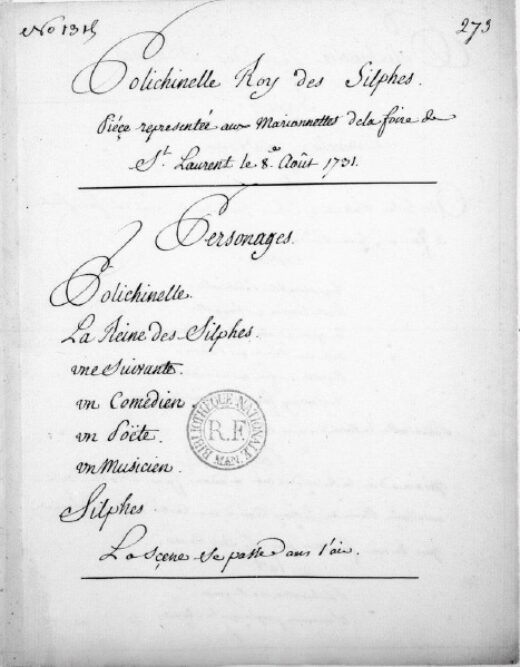
Printed
9 pages
Polichinelle roi des Sylphes
According to German-speaking doctor, philosopher and alchemist Paracelsus (1493-1541), Sylphs are air spirits. They appear in French literature for the first time in 1670, in Le Comte de Gabalis, ou Entretiens sur les sciences secrètes (The Count of Gabalis, or Interviews on the Secret Sciences), in which Henri de Montfaucon, also known as “l’abbé de Villars” (the abbot of Villars), satirises occult beliefs. He does so, however, in a romantic manner which some have failed to understand. The success of Comte de Gabalis was such that it inspired many tales, novels and theatrical variations on the sylph characters and their feminine counterparts, the sylphids.
The anonymous manuscript of the Soleinne Collection (Bibliothèque Nationale de France, Ms fr 9312), Polichinelle roi des Sylphes, follows this trend. More particularly, it follows two plays put on the year before: Biancolelli’s La Sylphide (The Sylphid), at the Comédie-Italienne, and Barthélémy-Christophe Fagan and Charles-François Panard’s comic opera Le Sylphe supposé (The supposed Sylph). However, as Françoise Rubellin, the editor of the text, observes, Polichinelle roi des Sylphes (Polichinelle king of the Sylphs) has very little in common with La Sylphide, and nothing at all with Le Sylphe supposé.
A satire of the people living in the capital
The Reine des Sylphes (queen of the Sylphs) declares her love to Polichinelle. The latter is taken into her palace in the air and praised by a Suivante (lady-in-waiting), a Comédien (comedian), a Poète (poet) and a Musicien (musician). Each provides opportunities to mock Parisian people’s immorality and idiosyncrasies. The Reine joins Polichinelle: together, they attend a divertissement danced by the Sylphes (Sylphs), and the final vaudeville.
First performance
Foire Saint-Laurent, Bienfait's puppets
Publications and translations
Françoise Rubellin (dir.), Marionnettes du XVIIIe siècle, Anthologie de textes rares. Montpellier: Espaces 34, 2022: 157-173.